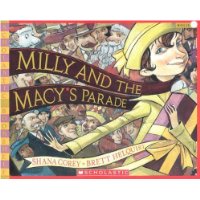| 商家名称 |
信用等级 |
购买信息 |
订购本书 |
|
|
 |
Milly And The Macy's Parade |
 |
|
 |
Milly And The Macy's Parade |
 |

基本信息·出版社:Scholastic Inc.
·页码:40 页
·出版日期:2006年10月
·ISBN:0439297559
·条形码:9780439297554
·装帧:平装
·正文语种:英语
·丛书名:Scholastic Bookshelf: Holiday
·外文书名:米利和梅西的列队游行
内容简介 It's 1924 and the holidays are approaching. Milly lives in NYC with her Polish family and frolics daily in holiday displays at the Macy's store under the watchful eye of Mr. Macy. But Milly's family misses their homeland and traditions. In an effort to cheer people up, Milly convinces Mr. Macy to combine old country traditions with new American heritage in a celebration for all to enjoy. Everyone agrees that the resulting parade will become a wonderful new tradition. This heartwarming story beautifully captures the creation of a uniquely American event.
编辑推荐 From Publishers Weekly Milly, the daughter of Polish immigrants, idolizes her dad's boss, Mr. Macy: he "was just about the most important person in America (next to the president of course)." So when Papa and his co-workers grow homesick for their Christmas tradition of "caroling from house to house," Milly takes her idea for "singing and strolling in the streets" straight to Mr. Macy. As her endnote explains, Corey's (You Forgot Your Skirt, Amelia Bloomer!) "history" of the Macy's Christmas Parade is more fanciful than factual, but it captures the flavor of its 1924 setting. (Parade enthusiasts should see also Pamela Pease's Macy's on Parade, noted above under "Thanksgiving.") Marching across the horizontal pages, the sharp-faced, pointy-nosed characters of Helquist's (illustrator of Lemony Snicket's books) spirited acrylic and oil illustrations may convey a more satirical mood than the text suggests, but period details bring the '20s roaring back to life. Ages 5-8.
Copyright 2002 Reed Business Information, Inc.
--This text refers to an out of print or unavailable edition of this title. From School Library Journal Kindergarten-Grade 3-The annual Macy's Thanksgiving Day Parade is a highlight of the New York City holiday season with its marching bands and big balloons. In this story, set in 1924, Corey envisions a little girl whose immigrant Polish father works for Mr. Macy himself. Milly has the run of the store and can fly through the revolving doors and ride up and down the escalators and the elevators. She and all the fashionably dressed customers think that the Christmas merchandise is "gorgeous." But while Milly and her family are growing accustomed to America, they miss one wonderful custom from the old country: strolling from house to house singing Christmas carols. The child determinedly proposes to Mr. Macy a parade as an alternative. The marchers begin in Harlem with festive costumes, bands, and animals from the Central Park Zoo and end up on 34th Street. And so the annual festivity takes root. Helquist's acrylic-and-oil paintings feature colorfully dressed people with angular faces and bodies outlined in black. The author's note gives a history of the parade and acknowledges that while R. H. Macy himself died in 1877, he is a known character "-immortalized in the 1947 classic book and film Miracle on 34th Street-." While the references to the Follies and the Rockefellers and the Vanderbilts may be lost on children, this is an entertaining and lively variation on holiday stories.
Susan Pine, New York Public LibraryCopyright 2002 Reed Business Information, Inc.
--This text refers to an out of print or unavailable edition of this title. From Booklist PreS-Gr. 2. Mixing fact and fiction, Corey fashions a story about how the Macy's Parade came into being in 1924. The fictional heroine Millie is a Polish immigrant child whose father works on the loading docks at Macy's, where she spends many afternoons visiting Mr. Macy in his office. She also likes riding the elevators, loitering in ladies' lingerie, and trying out toys. Millie is happy, but Papa and his friends are homesick for their countries. She brings the problem to Mr. Macy, and together they cook up the idea of a holiday parade, which, of course, has become a seasonal tradition. The author's note states that most of the story isn't true, but the immigrant origins of the parade are based in fact. Obvious plot points are ignored (How did Millie meet Mr. Macy in the first place?), but the happy spirit of the holidays pervades the tale. Helquist, who illustrated the Lemony Snicket books, provides colorful chalk art with interesting perspectives. There's a visual sharpness to the characters that doesn't quite say "Season's Greetings," but the many era-specific pictures take children back in time.
Ilene CooperCopyright © American Library Association. All rights reserved --This text refers to an out of print or unavailable edition of this title.




